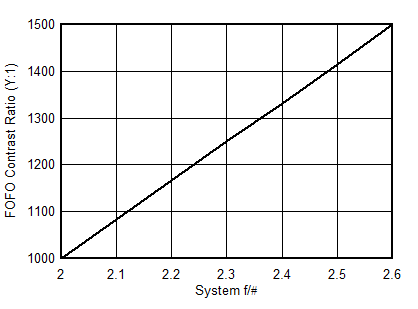JAJU617A October 2018 – May 2022
- 概要
- Resources
- 特長
- アプリケーション
- 5
- 1System Description
- 2System Overview
- 3Hardware, Software, Testing Requirements, and Test Results
- 4Design Files
- 5Software Files
- 6Related Documentation
- 7Terminology
- 8Revision History
2.4.2.2 Aperture Size: Selecting f/# of Optics
The f/# of an optical system refers to the size of the aperture. For a DLP projector, there are apertures in the illumination and projection path, and typically the f/# of each one should match. The DLP3030-Q1 DMD has a tilt angle of ±12°, which corresponds to f/2.4, as dictated by the following angle-f/# relationship:
However, an optical designer may prefer to open or close the aperture, by decreasing or increasing the f/# respectively. By opening the aperture, this allows more light to pass through and increases the brightness. However, this also allows light from the illumination- and flat-state pupils to leak into the off-state pupil, which raises the black level and degrades the contrast. Closing the aperture reducing the etendue match and allows less light through, but also increases the contrast by separating the pupils.
Figure 2-8 shows this tradeoff of contrast and brightness with a varying f/#. To support a HUD design with 1500:1 contrast, and aperture of f/2.6 should be used.
 Figure 2-8 Picture Generation Unit Contrast and Brightness vs f/#
Figure 2-8 Picture Generation Unit Contrast and Brightness vs f/#